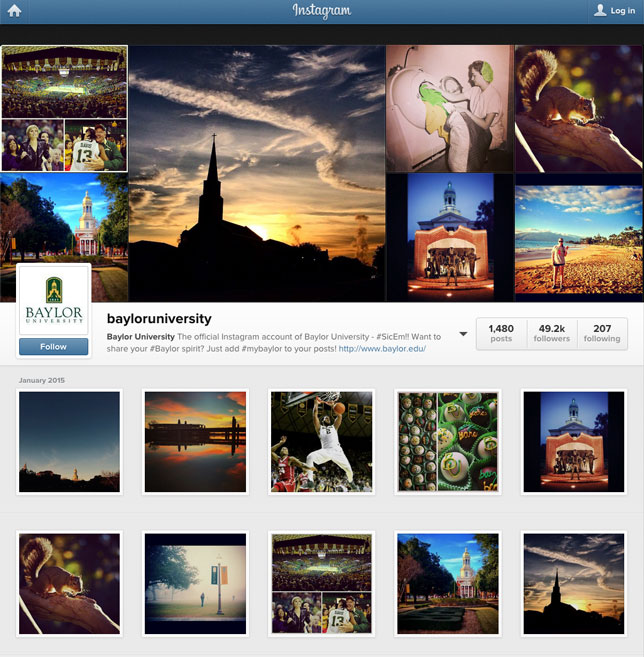How Digital Asset Management Makes Social Media More Effective at Baylor
Baylor University in Waco, TX, is the
sixth most influential college on Instagram, according to College Atlas, and
the university attributes this success to its digital asset management (DAM)
solution. The technology enables Baylor staff to post professional photos to social media
outlets within seconds, so people can easily follow academic and athletic news
and events.

Baylor University's Instagram page
Challenge of Social Media
Prior to the social media boom, Baylor used traditional media
outlets such as print, billboards, radio and TV to get its message out to
potential students, parents, friends of the university and other interested
parties. When social media caught on, Baylor saw the technology's potential as a more timely
communication medium and started investigating ways to take advantage of it. The
university now uses Facebook, Instagram and Twitter as its primarily social
media outlets. It also uses Pinterest and Tumblr to showcase photos, and YouTube
and Vimeo for videos.
Baylor started using Instagram as a type of viewbook — a dynamic daily look at the
university rather than a static
annual publication. But the immediacy of Instagram and other social media created a
challenge: how to populate sites with the latest content and
promote the university. In the beginning, staff would shoot photos with their
phones and post them to Instagram, but the quality of the photos was low.
Alternatively, staff photographers would shoot with digital SLRs and
e-mail the photos to the social media team, but the images would sometimes get lost in
a junk e-mail folder or otherwise missed. The university wanted a way to shoot
high quality photos and post them immediately.
Baylor solved part of the problem with a wireless file transfer device for
its Canon digital cameras, which lets the university's photographers connect their
camera to a WiFi network and quickly upload photos to the university's server.
That technology solved the problem of uploading high quality photos quickly, but
the photographers are not administrators of the university's social media
outlets, so the next step was to find a solution that would put the photos at
the digital fingertips of marketing and communications staff, so they could post them on Facebook
and Twitter as quickly as possible.
Insta-DAM Solution
The Marketing and Communications department at Baylor had been using
Portfolio
from Extensis as its digital asset
management system for a number of years. Approximately 1.5 million photos and
videos are stored on the Portfolio server with accompanying metadata, so staff
can quickly search for and retrieve the assets they need. However, staff needed
a license to access those digital assets, which created a barrier to sharing
images quickly and easily from anywhere.
When Extensis added
Netpublish — a tool for creating internal file-sharing Web sites — to its
Portfolio suite, Baylor adopted it. According to Robert Rogers, director of
photography for the university, Netpublish streamlined the process of
distributing the images, whether to the university's social media team,
local media outlets or other university staff.
Now, when Rogers or another university photographer is at an event, such as a
game or commencement ceremony, they can shoot pictures, connect the camera's
wireless transfer card to a WiFi network, upload the photos to Baylor's
Portfolio server, and they're automatically posted on Baylor's Netpublish site.
From there, the social media team can grab the photos they like and post them on
their social media pages.
The system has created the immediacy that Baylor wanted and that's so crucial
to social media success. With Netpublish, Baylor's social media team can access
photos seconds after they were taken, just by going to a Web page. From there,
they can select the photos they want to use, add captions and post them. "It's
probably a half a second transfer time, and then the team from social media can
see these images as if they're there with us," said Rogers. "No matter where
they are, they can see what we're seeing and share that stuff immediately."
Baylor creates what is called a "live link" for each event as it happens. The
university can easily share that live link with traditional media outlets or
other stakeholders to provide them with quick access to high-quality photos of
the event. If Baylor wants to revoke access to those photos, staffers simply remove
the live link.
Getting Engaged
Baylor University has been on
Instagram for two years now and has more than 49,000 followers. According to
Rogers, its engagement rate — the percentage of followers who like, share or
comment on posts — is 10 to 12 percent, whereas the average engagement rate on
Instagram is 4.21 percent, according to a recent blog post by
Nate Elliott, an analyst for Forrester Research.
Rogers attributes the university's high rate of social media engagement to
the quality and immediacy of its photo posts. When Baylor's softball team made
it to the World Series, the social media team posted live photos on
Twitter as they came in from the
camera. According to Rogers, they tripled their number of followers on Twitter
from that single event and now have 41,500 followers on that platform. "Having a
professional photo and releasing it immediately is really advantageous to
getting better engagement and better overall feel for the university," he said.
"Statistically, I think it's nearly 10 times the engagement of a simple post
with text."
"And [social media engagement] does filter down into higher application
rates," said Rogers. "I'm not saying that it's Instagram or Facebook
specifically, but it's one piece of this puzzle. So the reason we're having
record enrollment and record class sizes, the reason we're having record giving,
things like that, is just overall a better overall feeling of the university. And
if we can help with that in one channel by intimate and immediate imagery,
that's a great thing."